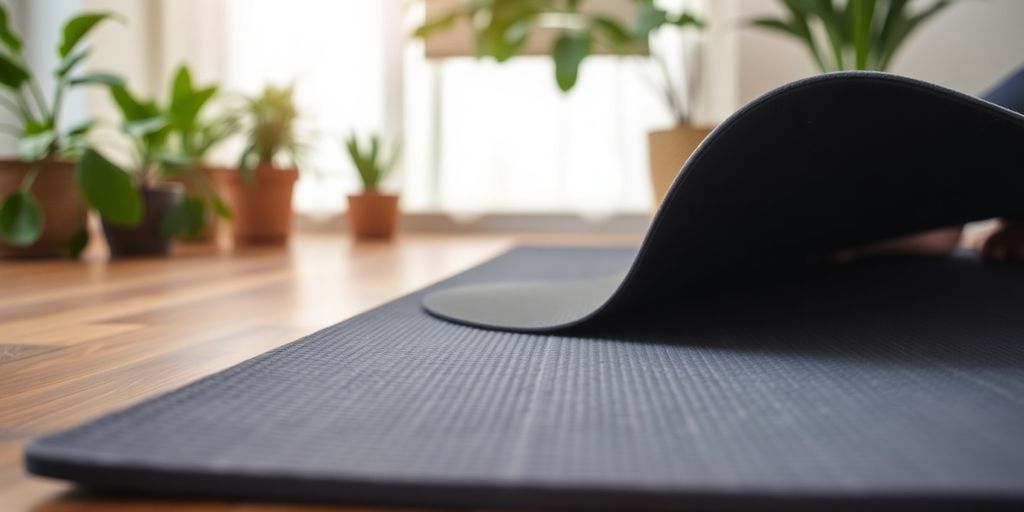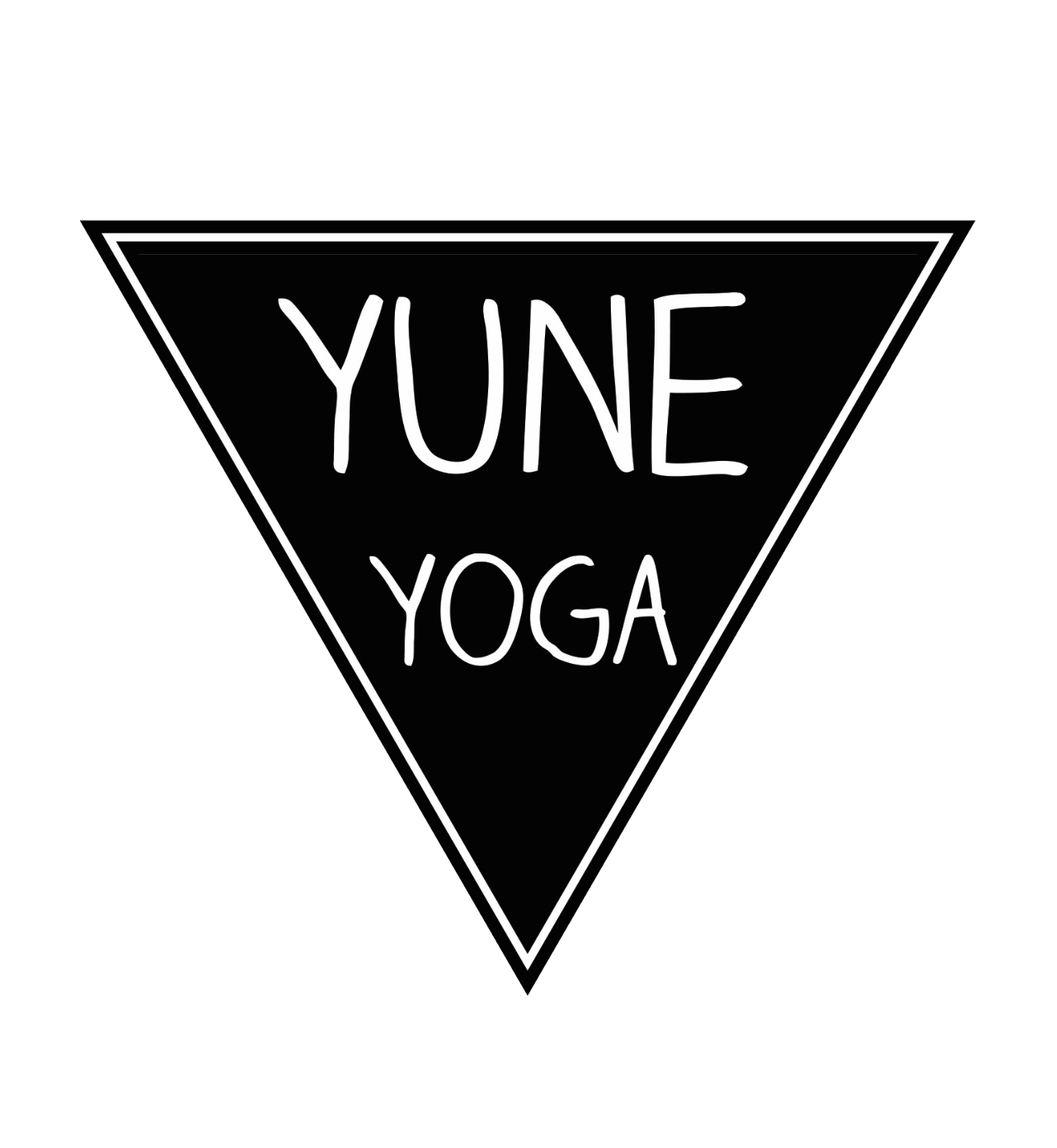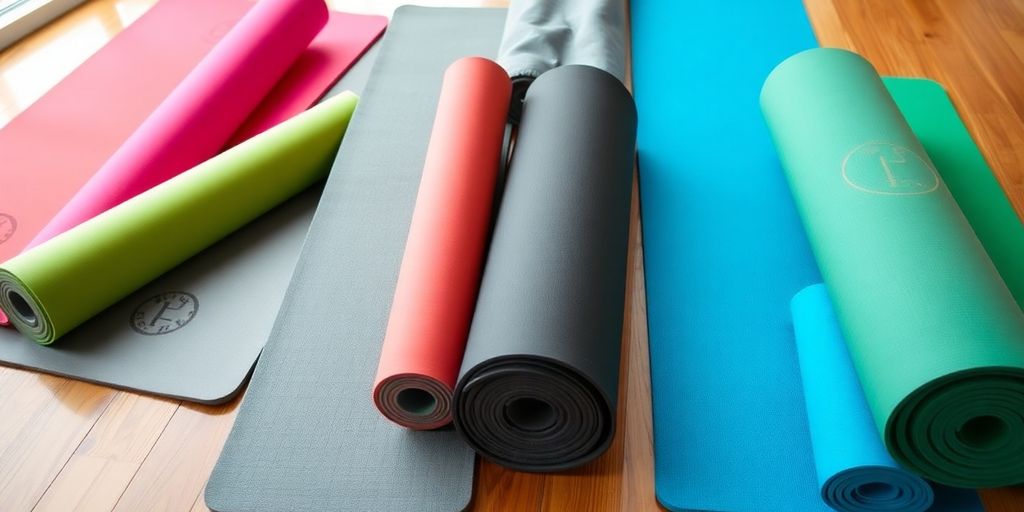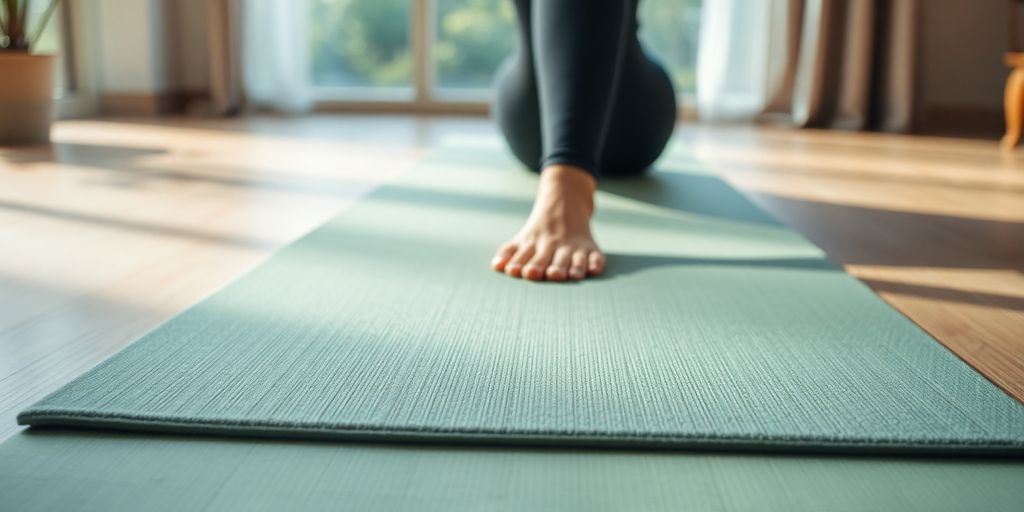
Discover the Benefits of a Yoga Mat Thick Non Slip for Your Practice
Ever tried yoga on a mat that feels like a hardwood floor? Not the best experience, right? That's where a thick non slip yoga mat comes in handy. It's like moving from a thin blanket to a plush carpet. The extra padding offers more than just comfort; it supports your body in ways a regular mat just can't. So, whether you're stretching into a warrior pose or lying down for some meditation, a thicker mat can make a world of difference.
Key Takeaways
- A thick non slip yoga mat provides extra cushioning for joints, making it ideal for those with sensitive knees or elbows.
- Thicker mats can enhance balance and stability, especially helpful for beginners learning new poses.
- Durability is a major plus; these mats often last longer, saving you money over time.
- Consider the material and grip of the mat to ensure it meets your comfort and safety needs.
- Proper care and storage can extend the lifespan of your thick yoga mat, maintaining its quality.
Understanding the Importance of a Thick Non Slip Yoga Mat

Enhanced Joint Protection
Ever tried doing yoga on a bare floor? Not the most comfortable experience. A thick yoga mat is like a cushion for your joints—your knees, elbows, and wrists will thank you. This is especially true for styles like restorative yoga or Pilates, where you hold poses for a bit longer. It’s not just about comfort; it’s about keeping those joints safe from the hard ground.
Improved Balance and Stability
Balance can be tricky, especially when you're trying new poses. A thick mat gives you a stable base, kind of like a safety net, helping you hold those poses without wobbling. Whether you're a newbie or a pro, having that extra stability is a confidence booster. You can focus more on your alignment and breathing rather than worrying about slipping.
Better Protection Against Hard Surfaces
Practicing on a hard surface can really take the joy out of yoga. A thick non-slip mat acts as a barrier between you and the floor, letting you concentrate on your flow rather than the discomfort. This added layer not only makes your session more pleasant but also safer, reducing the risk of injuries from falls or slips. It's a small investment for a big improvement in your yoga experience.
Investing in a thick exercise mat can significantly enhance your comfort and safety during workouts, offering a blend of cushioning and stability that supports your practice.
Choosing the Right Thick Non Slip Yoga Mat for Your Needs
Material and Texture Considerations
When picking out a yoga mat, the material is a big deal. You want something that feels good and lasts a long time. Natural rubber or eco-friendly options like PER are great because they're tough and free from harmful chemicals. And don't forget about texture—a non-slip surface is essential. It keeps you grounded, especially in those tricky poses.
Optimal Thickness for Different Practices
Thickness isn't just a number; it's about how it feels when you're on the mat. If you're into gentle or restorative yoga, something around 8-12mm can offer that cloud-like comfort. But if you're doing more active styles like Vinyasa, you'll want to stick to something around 5-6mm. This thickness helps with balance while still giving enough cushioning for your joints.
Selecting the Best Mat for Beginners
Starting out in yoga? You want a mat that gives you confidence. Look for a mat with a good grip and enough padding to protect your joints. Beginners often benefit from a thicker mat, around 6-8mm, which provides extra cushioning while you learn the ropes. Plus, a non-slip texture can help you feel more secure as you try new poses.
Choosing the right yoga mat is like finding a good pair of shoes. It needs to fit well and feel right for what you're doing. Whether you're a beginner or seasoned yogi, the right mat can make a big difference in your practice.
Maximizing the Benefits of a Thick Non Slip Yoga Mat
Proper Care and Maintenance
Taking care of your yoga mat is like looking after a trusted friend. Regular cleaning keeps it fresh and long-lasting. After every session, give your mat a quick wipe with a damp cloth and some mild soap. This helps prevent sweat and dirt from building up. Avoid harsh chemicals—they can mess up the material. Every once in a while, treat it to a deeper clean by soaking it in warm water with mild soap. When storing, roll it with the top side out to avoid those annoying curled edges. Keep it in a cool, dry spot, away from direct sunlight.
Incorporating Props for Added Support
Props can take your yoga practice to the next level, especially when paired with a thick mat. Blocks, straps, and bolsters offer extra support and help you maintain the right alignment in tricky poses. They can also make some poses more doable, letting you gradually deepen your practice. Try a bolster under your knees during seated poses or a block under your hand in standing poses to keep your balance steady.
Adapting for High-Intensity Workouts
Though yoga is the main game, a thick mat can be your go-to for high-intensity workouts too. Think HIIT or circuit training with lots of floor exercises. The cushioning helps reduce the impact on your joints. Plus, the stability a thick mat offers can really help you keep proper form during exercises like planks or push-ups. If you're stuck between a thick and a thin yoga mat, remember that a thicker one might be just what you need for those intense sessions.
A thick non-slip yoga mat is more than just a piece of equipment; it's a partner in your fitness journey. Whether you're doing yoga or mixing it up with other workouts, it offers the cushioning and stability you need to stay comfortable and safe.
Enhancing Your Practice with a Non Slip Yoga Mat
Boosting Confidence in Your Practice
Having a non-slip yoga mat is like having a reliable partner by your side. You know how it is—trying new poses can be a bit nerve-wracking, but with a mat that grips, you can focus more on your form and less on slipping. Imagine nailing that tricky pose because your mat's got your back. It’s a confidence booster for sure, making your practice more enjoyable and fulfilling over time.
Reducing the Risk of Injury
Safety is a big deal in yoga. A mat with a good grip reduces the chances of those unexpected slips that could lead to injuries. Especially when you're transitioning between poses or in a dynamic flow, having a stable base is crucial. A non-slip mat provides that security, allowing you to move fluidly and safely, making every session a worry-free experience.
Creating a Dedicated Practice Space
Your yoga mat is your personal space, a place where you can tune out the world and focus on yourself. A non-slip mat helps create this dedicated practice area, offering a stable and comfortable surface for your exercises. It's like having your own little sanctuary, where you can unwind and recharge, free from distractions. This dedicated space can significantly enhance your overall yoga experience.
Choosing the right non-slip yoga mat can truly enhance your practice, offering the perfect blend of comfort, stability, and sustainability. Make sure to consider what's most important for your practice and lifestyle.
Whether you're a newbie or a seasoned pro, having that extra grip can make a world of difference. No more worrying about sliding around or losing your balance. Plus, with all the cool designs and eco-friendly options out there, like the Yune Yoga Mat in Hatsumi Orange, you can find one that fits your style and values. It's not just about safety and stability—it's about making your practice more enjoyable and personal. Happy practicing!
Versatility of a Thick Non Slip Yoga Mat Across Yoga Styles
Yoga mats aren't just pieces of rubber or foam; they're essential tools that can transform your practice. With a thick non-slip yoga mat, you have a versatile companion that adapts to various yoga styles, offering comfort, stability, and safety.
Suitable for Hatha Yoga
Hatha yoga is all about those long, steady poses and mindful breathing. It's the kind of practice where a thick mat really shines. The extra cushioning can be a game-changer, especially if you're holding poses for what feels like forever. No more feeling like you're pressing down on concrete. Plus, the non-slip surface keeps you grounded, letting you focus on your breath and alignment without the fear of slipping. It's like having a little safety net beneath you, which is especially great for beginners who are still finding their footing.
Ideal for Vinyasa Yoga
Vinyasa is a flow-based practice, moving from one pose to the next with grace and speed. This is where a thick mat can be your best friend. It offers a stable base for all those transitions, and the cushioning can save your joints from taking a beating during those quick sequences. The non-slip feature is crucial here, too, ensuring your hands and feet stay put as you flow through your practice. Think of it as having a trusty partner who supports every move you make.
Perfect for Yin Yoga
Yin yoga is all about deep, relaxing stretches. Here, a thick mat provides the comfort you need to really sink into those poses for extended periods. You won't have to worry about feeling the hard floor underneath, which can make a world of difference when you're holding a pose for several minutes. The non-slip surface helps you stay in place so you can focus on relaxing and breathing deeply. It's like having a cushiony cloud that supports you completely, making it easier to let go and unwind.
The Role of Thickness in Stability and Comfort

Balancing Cushioning and Stability
Finding the right thickness in a yoga mat is like trying to get the perfect amount of peanut butter on your toast—not too much, not too little. A thick exercise mat provides that extra cushioning which is great for your knees and elbows, especially if you're practicing on a hard floor. But here's the catch: too much thickness can make you feel like you're on a waterbed, wobbling around during poses like Tree Pose. So, what's the sweet spot? Most folks find that a mat around 5mm thick gives a good balance. It's enough to protect those joints without making you lose your footing.
Impact on Joint Support
If you've ever done yoga on a thin mat, you know the pain of having your knee dig into the ground during a lunge. Ouch! A thicker mat can be a game-changer here. It absorbs shock and reduces the stress on joints, which is especially great if you're dealing with any joint issues. Think of it as a cushiony friend that’s got your back—or knees, in this case.
Finding the Right Thickness for You
Choosing the right thickness is like picking the right pair of shoes. It totally depends on what you need. If you're into gentle yoga styles like Hatha or Yin, you might appreciate a thicker mat for the extra comfort. But if you're all about those intense Vinyasa flows, you might want something a bit thinner to keep your balance in check. Here's a quick list to help you decide:
- Gentle Yoga Practices: Opt for mats 6mm or thicker for maximum comfort.
- Dynamic Practices: A 3-5mm mat helps maintain stability.
- Travel and Portability: Consider a thinner mat, around 1-2mm, for easy packing.
Picking the right mat thickness isn't just about comfort or style; it's about making your practice more enjoyable and less about enduring discomfort. Find what feels right for you, and your body will thank you.
Expert Tips for Using a Thick Non Slip Yoga Mat Effectively
Balancing Cushioning and Stability
Finding the sweet spot between cushioning and stability can be a bit tricky. A thick mat gives you that cozy feel, but it might throw you off balance during certain poses. Engage your core muscles to help stabilize yourself. Think of your mat as a supportive partner rather than a crutch. If it feels too squishy, try practicing on a firmer surface until you get the hang of it.
Incorporating Props for Added Support
Props can be game-changers in your yoga practice, especially with a thick mat. Consider using blocks, straps, or bolsters to help maintain alignment and add support. These tools can help you ease into poses and hold them longer. For example, a block under your hand in a standing pose can help you balance better.
Adapting for High-Intensity Workouts
Your thick mat isn't just for yoga. It's also great for high-intensity workouts like HIIT or circuit training. The extra cushioning helps reduce the impact on your joints during floor exercises. Plus, the stability from a thick mat aids in maintaining proper form during exercises like planks or push-ups. If you're torn between a thick and thin mat, remember that a thicker one might be your best bet for these intense sessions.
Remember, the right mat can enhance your practice, but it's how you use it that truly matters. Tailor your mat choice to your personal needs and practice style, and you'll find yourself enjoying yoga even more.
For a mat that combines functionality with sustainability, consider the Oak Yoga Mat, which offers a 5mm thick, non-slip surface perfect for stability during workouts.
Enhancing Comfort and Support with a Thick Non Slip Yoga Mat
Experience Superior Cushioning
Ever tried yoga on a mat that feels like a hardwood floor? Not the best experience, right? That's where a thick non-slip yoga mat comes in handy. It's like moving from a thin blanket to a plush carpet. The extra padding offers more than just comfort; it supports your body in ways a regular mat just can't. So, whether you're stretching into a warrior pose or lying down for some meditation, a thicker mat can make a world of difference.
Reduce Joint Stress
Joint pain is a common complaint among yoga enthusiasts, especially on hard surfaces. A thick mat helps absorb shock, reducing the stress on your knees, elbows, and other sensitive areas. This is crucial for maintaining a consistent practice without discomfort. If you're someone who struggles with joint issues, investing in a thick mat could be a game-changer.
Hold Poses Longer Without Discomfort
The combination of thickness and non-slip features means you can hold poses longer without worrying about sliding or discomfort. This stability allows you to deepen your stretches and improve your flexibility over time. With a reliable mat beneath you, it's easier to concentrate on your breathing and alignment, rather than adjusting for discomfort.
A thick, non-slip yoga mat isn't just a piece of equipment; it's a versatile tool that enhances your practice, no matter the style. It offers comfort, stability, and support, making it an essential part of your yoga journey. Whether you're flowing through Vinyasa, holding steady in Hatha, or relaxing into Yin, this mat has got you covered.
When you're choosing a thick exercise mat, consider factors like thickness, material, and intended use to find the best option for your routine. This can make all the difference in your overall experience, helping you maintain a practice that's both safe and enjoyable.
Wrapping It Up: Why a Thick Non-Slip Yoga Mat is a Game-Changer
So, there you have it. A thick non-slip yoga mat isn't just a piece of gear; it's like your trusty sidekick in every yoga session. Whether you're a newbie or a seasoned pro, having that extra grip can make a world of difference. No more worrying about sliding around or losing your balance. Plus, with all the cool designs and eco-friendly options out there, you can find one that fits your style and values. It's not just about safety and stability—it's about making your practice more enjoyable and personal. So next time you roll out your mat, know that you're setting the stage for a better, more focused yoga experience. Happy practicing!
Frequently Asked Questions
Why is a thick non-slip yoga mat important for practice?
A thick non-slip yoga mat provides extra cushioning and stability, protecting your joints and helping you maintain balance during poses. It's especially helpful for beginners and those with sensitive knees or elbows.
What should I consider when choosing a yoga mat?
When picking a yoga mat, consider the material, thickness, and texture. Natural rubber or eco-friendly materials are durable and safe. The thickness should match your practice style, and a non-slip texture is crucial for stability.
How do I care for my thick yoga mat?
To keep your yoga mat in good shape, clean it regularly with a damp cloth and mild soap. Avoid harsh chemicals. Store it rolled up in a cool, dry place away from sunlight to prevent damage.
Can a thick yoga mat be used for other workouts?
Yes, a thick yoga mat is versatile and can be used for other workouts like HIIT or circuit training. The extra cushioning helps reduce joint impact, and the stability aids in maintaining proper form.
Is a thick yoga mat suitable for all yoga styles?
A thick yoga mat is great for various yoga styles. It offers support in Hatha and Yin yoga with its cushioning, and provides stability for dynamic styles like Vinyasa.
How does a non-slip yoga mat enhance safety?
A non-slip yoga mat reduces the risk of slipping during practice, especially in poses that require balance. This makes your practice safer and allows you to focus on form and breathing.


